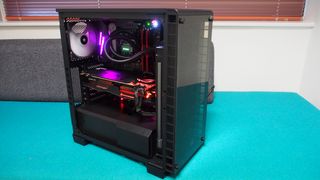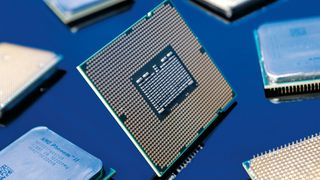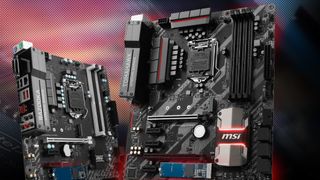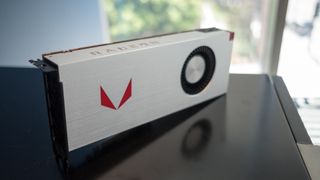PC components explained: how to create the best computer components list

Even if you already know how to build a pc, that’s only really half the story. The rest lies in finding the best PC components – like the best graphics card, motherboard, processor, RAM and more. This can be a lot to take in, especially if you’re new to the computing world, but you can rest assured that with a bit of planning and research, it couldn’t be easier.
With this in mind, we’ve created a tutorial that can help you find all the best PC components in order to build the best PC you could muster. We can set you on the right path to finding the best PC components, as having a good idea of what kind of computer you want to build can seriously help.
The budget
Forget what anyone tells you, every build should start with two key things. A budget, and ambition. The budget is obvious, how much cash are you willing to drop on your shiny new rig. And ambition? Well that’s finding out exactly what you want to do with your brand new machine.
Crazy as this might sound, the dollar value of a system with a budget of 700 bucks, is far higher than the value in a system with a budget of 4,000 simoleons. The lower the budget, the more you’ll have to stretch every buck to acquire multiple PC components. However, seasonal sales like can make budgets easier to work with.
We would advise that you set out to build a gaming PC that adheres to a single goal. Do you want one of the best gaming PCs? Or, would you rather have a home theater PC that can seamlessly blend into your living room? Do you want to edit video in 4K? All of these require different PC components to maximize savings and performance.
Even though most PCs should be able to handle basically any task, it’s better to focus on the PC components you really need. Because, with the best PCs, you don’t want a jack of all trades and a master of none.
Once you’ve settled on what you’re going to do and how much you want to spend, you then need to decide on what form factor you want to build in, whether you want to go AMD or Intel and then you’re all good.

Process this
We don’t call the CPU a central-processing unit for nothing, it’s literally the most essential part of any PC build and for that reason we’re starting here. Choosing the best processor starts with deciding between AMD or Intel as they’re the prevailing chipmakers in this category.
From there, it’s a matter of picking the right part for your budget. AMD Athlon as well as Intel Pentium and Celeron are affordable and best suited for basic computing tasks, media playback and simple lifestyle applications. Meanwhile, Intel Core and AMD Ryzen serve the widest gamut of users looking to build anything from a cheap HTPC to an enthusiast gaming PC. Lastly on the high-end tier, there are the Intel Core X and AMD Ryzen Threadripper for more intense workloads like video production, 3D modeling and streaming gamers.
Intel’s Core i5 series of CPUs has traditionally been the go-to chip for gamers. This is because most mainstream games (outside of the odd strategy title) are more graphically intensive than CPU intensive, so you don’t need the most baller silicon. So, for the most bang for the buck, the i5 was and still is ideal. The i5-8400 is the perfect chip for those on a budget, as it’ll keep pace with last gen’s top-end Core i7-7700K in most computational tasks.
And of course, because AMD is finally back in action, we absolutely recommend the AMD Ryzen 5 2600X as well. Both Intel’s i5-8400 and AMD’s Ryzen 5 2600X pack a phenomenal punch when it comes to gaming. Intel slightly edges out on in-game frame rates single-core performance, while AMD swings back in computational tasks, and more demanding workloads.
So what do we mean by that? Basically, the Ryzen 5 2600X packs multi-threading, meaning six cores and 12 threads of unadulterated Ryzen fury, and a whole ton of spare processing power for any and all applications you’re running on the side, making it perfect for streaming.

The mother of all boards
No good CPU goes without a good motherboard. Depending on what chip you choose, you’ll be locked into a selection of mobos with a variety of different chipsets available to you. But the first question we’ll help you answer is, what size motherboard is right for you?
ATX, E-ATX and XL-ATX boards are geared towards vast storage solutions, and hefty graphics card setups. And if you’re after a smaller system, Micro-ATX or Mini-ITX is your jam, providing a more compact size – though at the cost of fewer slots for graphics cards and other PCIe add-in cards.
From there your choice of processor will also determine, which motherboard will work with your system. This includes ensuring the CPU sockets lineup as well as having the right chipset. For example, Intel Coffee Lake and Kaby Lake chips technically plop down on the same LGA1151, but the former requires a 300-series chipset while the latter was launched with the 200-series chipset. Similarly, Ryzen and Ryzen 2nd Generation both share the same AM4 socket, but the latest AMD chips see the most benefit from the latest X470 platform.
Depending on the size of your chassis and if you’ve gone with an Intel processor, this ASRock Fatal1ty Z370 Gaming K6 (for ATX), Asus Z370-G (for Micro-ATX), or Asus ROG Strix Z370-I Gaming (Mini-ITX) all fit the bill perfect for a modern Intel-powered PC.
For our AMD builders, we’d recommend the Aorus X470 Gaming 7 Wi-Fi for an ATX build, the MSI B350M Mortar (a real fine budget board), for Micro-ATX rigs, and the ASUS ROG Strix X470-I Gaming for the mini-ITX lovers out there.
Ultimately, whether you go with our suggestions or not, it’s always worth remembering that your choice of motherboard will ultimately dictate your feature-set, memory and storage, your case, and how well your chip will overclock (if you invest in an unlocked part).

Graphics cards
Finishing out the trinity of every PC builds’ main components, graphics cards determines what your desktop will be able to visually render. While PCs can get away with just integrated graphics for simple tasks and even 4K streaming, creating your own media and gaming box requires the discrete graphical power that only an dedicated GPU can offer.
If your aim is to game at 1080p, the GeForce GTX 1060 3GB is your man. It’s the best bang-for-the-buck card out there is, capable of easily hitting 60fps in most, if not all AAA titles at 1080p. It won’t let you down for at least the next 3 years. If you really do need the extra VRAM for memory intensive games (here’s looking at you Witcher 3), then simply pump up for the 6GB variant instead.
There are alternatives out there, AMD’s Radeon RX Vega 64, Vega 54 and RX 580(if you can find them), are fantastic combatants to this card, but they just can’t keep up on a pricing level.
However, if you really want to go all-out and do some high-end 4K gaming, you’re going to want to drop some stacks on the Nvidia GeForce RTX 2080 or the RTX 2080 Ti. Now, these are expensive cards, but if you want no-holds-barred 4K gaming that’ll make the PS4 Pro look like a cheap toy, you’re going to want the 11GB of GDDR6 VRAM and 4,352 CUDA cores only the 2080 Ti can offer.

Comments
Post a Comment